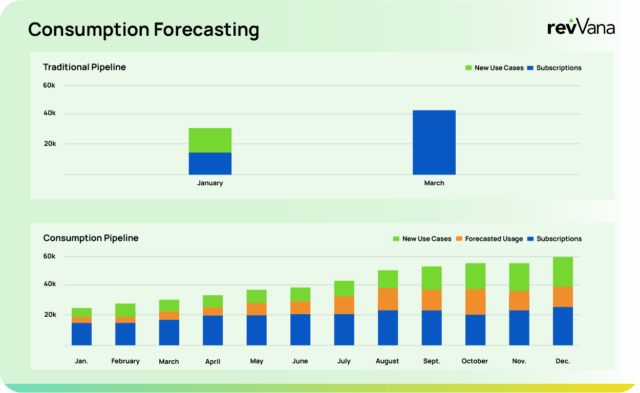Forecasting revenue is never easy, but for companies with usage-based business models, it’s especially complex. Traditional forecasting approaches often break down when revenue isn’t tied to fixed subscription fees or deal stages, but instead to how much your product is actually used.
In these models, the revenue isn’t locked in at the point of sale. It fluctuates with behavior, monthly usage, seasonal demand, or customer growth over time. That creates uncertainty. But it also opens the door to deeper forecasting precision, if the right pieces are in place.
Here are five key capabilities every usage-based company needs to forecast with confidence.
1. Centralized Visibility Into Customer Usage
Revenue in usage-based models is tied directly to how your product or service is consumed. The moment that usage data becomes siloed, living only in product analytics tools or buried in spreadsheets, it becomes nearly impossible to generate a complete, trustworthy forecast.
That’s why one of the most important steps is making usage metrics visible and connected to revenue planning. Whether it’s API calls, ad impressions, data volume, or user activity, that data needs to be accessible and up to date. Ideally, it should be connected to the customer or opportunity record in your CRM. This not only supports forecasting, but also helps teams understand what’s driving revenue changes in real time.
2. Revenue Forecasting That Starts After the Deal Closes
Most forecasting tools are built around pipeline progression: how likely is a deal to close, and when? That’s useful, but it doesn’t tell the full story for usage-based businesses.
The real question isn’t just whether a deal will close. It’s how much value it will generate once it does.
Forecasting in usage-based environments requires projecting revenue behavior over time: ramp periods, usage thresholds, seasonal shifts, or expected customer expansion. It’s not about a single number, it’s about a timeline of potential outcomes, rooted in both historical patterns and forward-looking inputs.
3. A Forecasting Loop That Learns From Actuals
Forecasting isn’t a one-time exercise. It’s an ongoing process that improves when you consistently compare your projections to actual results. But that learning loop often breaks when actuals live in disconnected systems, or when the process of reconciling them is entirely manual.
Usage-based companies need a way to continuously feed actual performance data back into the forecasting process. This creates a tighter, more reliable loop, so you can see what’s working, what’s off, and where adjustments are needed. Without this, forecasts stay static, even when your business is changing.
4. A Connected Workflow Across Sales, Finance, and Product
Accurate forecasting depends on alignment. In usage-based models, that alignment has to span multiple teams: Sales understands what’s in motion with customers. Product holds the usage data. Finance tracks actuals and builds forecasts.
When these functions operate in silos, forecasting becomes slower, less accurate, and harder to trust.
Centralizing your forecasting process, ideally in or near your CRM, helps create a shared source of truth across teams. It keeps everyone working from the same assumptions, with access to the same inputs. And it turns forecasting into a team function, not just a Finance responsibility.
5. The Flexibility to Adapt to Change
Usage-based revenue is inherently variable. Customer behavior shifts. Product usage evolves. Pricing models get refined.
Your forecasting process needs to be flexible enough to account for this. Rigid models or manual spreadsheets can’t keep up with fast-moving data. Forecasting needs to accommodate changes in usage trends, customer growth rates, or even external factors that impact demand.
That doesn’t mean over-engineering the process, it means building systems that can evolve alongside your business. Forecasts should be adjustable, iterative, and responsive, not locked in.

Forecasting in usage-based models isn’t just a finance task. It’s a company-wide capability. It depends on shared data, flexible tools, and a mindset that treats forecasting as an ongoing practice, not just a quarterly routine.
At revVana, we work with companies that operate in complex revenue environments, from usage-based to project-driven models, to help them improve forecasting accuracy, streamline workflows, and keep revenue planning close to the systems where their teams already work.






